Sea turtles are seen as strong, brave, guardians of the Earth, but their tough shells and patient ways are fragile in the reality of the world.
Sea turtles have charmed their way throughout the world with their magnificent features representing tranquility, wisdom, peace, and so much more. Their unique and natural traits have placed them in a special category of herpetofauna, and it is easy to see why they are a favorite among many, myself included. You can imagine the excitement I felt when I got the opportunity to tour and interview Loggerhead Marinelife Center, one of the world’s largest sea turtle hospital and research facilities in the world, for REPTILES magazine. Loggerhead Marinelife Center is located in Juno Beach, Florida, which is a sea turtle hotspot of the world. Like all turtles, sea turtles are in need of active conservation for their species.
Below is my interview with the staff about their amazing sea turtle conservation efforts. Experts Dr. Max Polyak (LMC’s Director of Rehabilitation and Attending Veterinarian) and Dr. Justin Perrault (LMC’s Director of Research) kindly answered my questions for REPTILES magazine.
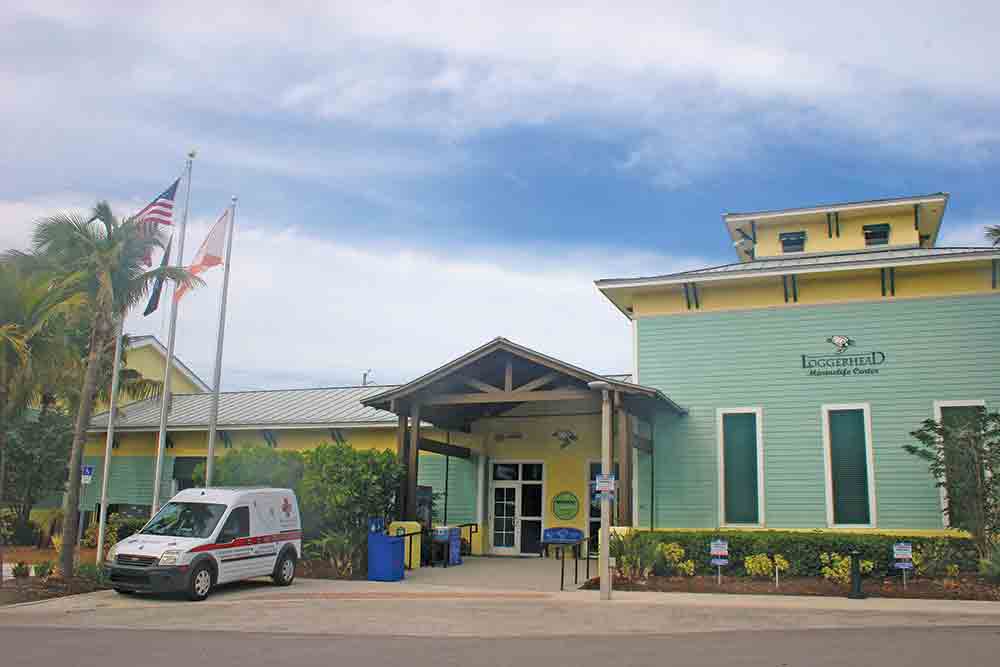
LMC is the only sea turtle hospital between Orlando and the Florida Keys. Photo by Rebekah Pettit
Rebekah Pettit: What is the history of LMC? How did you get started and how long have you been around?
Loggerhead Marinelife Center: Over 30 years ago, long-time Juno Beach resident Eleanor Fletcher started what is now the Loggerhead Marinelife Center. Eleanor and her husband Robert had a real estate business in Juno Beach. Eleanor noticed the abundance of sea turtles nesting on our shore in spring and summer. She was curious about why so many hatchlings headed landward after hatching, rather than back to sea, and as a result, began some of the earliest research on sea turtles in our area. Juno Beach is now recognized as one of the most active nesting beaches in the world! Eleanor became known as “The Turtle Lady” throughout the area.
Study Highlights Marine Plastic Ingestion In Sea Turtles
Researchers Create Computer Model To Track Hatchling Sea Turtles
As Eleanor Fletcher learned more and more about the sea turtles, she began to see that the turtles were threatened by the encroachment of man as he moved and built closer and closer to the shoreline. She decided that educating children about the sea turtles and the need for conservation and protection was the best hope for the sea turtles to survive over the long term. She began giving classes, first in her home, then above the real estate office as more and more children enjoyed her programs.
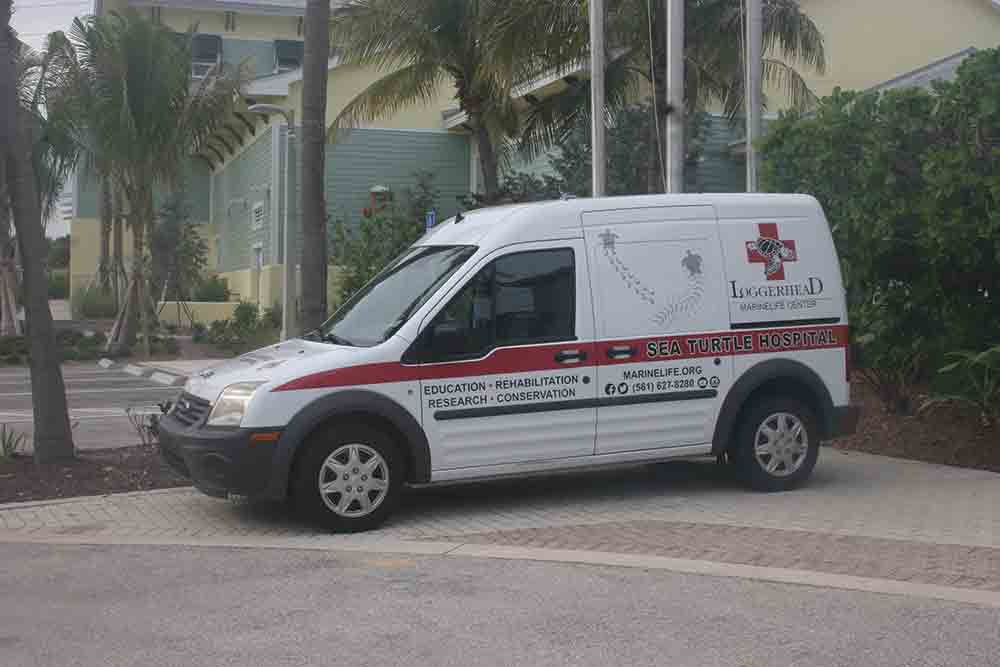
The ambulance that is dispatched to transport injured sea turtles. Photo by Rebekah Pettit
In 1983 the Children’s Museum of Juno Beach was incorporated, moving into what had been an old home in Loggerhead Park, thanks to the County’s Department of Parks and Recreation. Reflecting an expanded mission, the name was changed to The Marinelife Center of Juno Beach in 1990.
The center now hosts thousands of school children each year through field trips, outreach programs, summer camp and other educational experiences. In addition, more than 350,000 guests visit the center each year to see the exhibits and the sea turtle hospital – the only sea turtle hospital between Orlando and the Florida Keys.
In April 2007, the organization relocated to a new 12,000 square foot certified “green” facility and changed its name to Loggerhead Marinelife Center. The new facility includes a state-of-the-art veterinary hospital, among the largest and busiest of its kind in the world, exhibit hall, outdoor classroom, research lab, and resource center.
RP: Are you an AZA Facility or a privately owned facility and does LMC work with the SSP (species survival programs) with AZA?
LMC: We are a 501(c)(3) nonprofit facility. We are not a zoo or an aquarium but instead an active sea turtle hospital and research center. We do not work with SPPs, we work with species recovery efforts with the Florida Fish and Wildlife Commission, US Fish and Wildlife Service, and National Marine Fisheries Service.
RP: Are the permits required for sea turtle conservation challenging to obtain? Does it take a long time to be approved by FWC? Is FWC Helpful?
LMC: Different permits have different requirements, but most of them require documented experience with the activities being requested on the permit as well as attendance at certain mandatory meetings held by FWC. Some permits require you to pass a test as well. Any research projects require a full research proposal that is sent to experts in the field for peer review prior to approval. Depending on the permit activities being requested, this process can take months.
RP: Do you work with other turtle conservatories? What is your biggest event at the LMC?
LMC: Yes, we work with 187+ conservation partners spread across six continents. We also are the flagship hospital for the Sea Turtle Rescue Alliance. Our biggest event would be TurtleFest, despite having to put it on pause in 2020 and 2021. It traditionally welcomed more than 15,000 guests on campus and we are planning to re-introduce the event in 2022.
RP: What is the rarest species here/rescued/to visit Juno beach?
LMC: Locally, on Juno Beach, the olive ridley is the rarest species. However, Kemp’s ridleys are the rarest overall due to their critically endangered status.
RP: How many sea turtle nests are found per year on average? What is the highest number of nests found so far?
LMC: Since 2000, on our 9.5 miles of beach, we average just over 11,000 nests per year of all three species. Since 2010, that average has jumped up to 14,500/year. The highest number of sea turtle nests recorded on Juno Beach, FL was 20,998 in 2019.
RP: How many events are there at LMC?
LMC: We have many year-round and seasonal programs. However, we have several signature events, including Hike2O, TurtleFest, Run 4 the Sea and the Go Blue Awards.
RP: Why is Juno Beach so special for sea turtles?
LMC: Juno Beach is a unique place for sea turtles as it is one of the most densely nested sea turtle beaches in the world. This Gulf Stream is a major ocean current and “conveyor belt” of sea life that kisses the southeast coast where we’re located.
Husbandry and Health
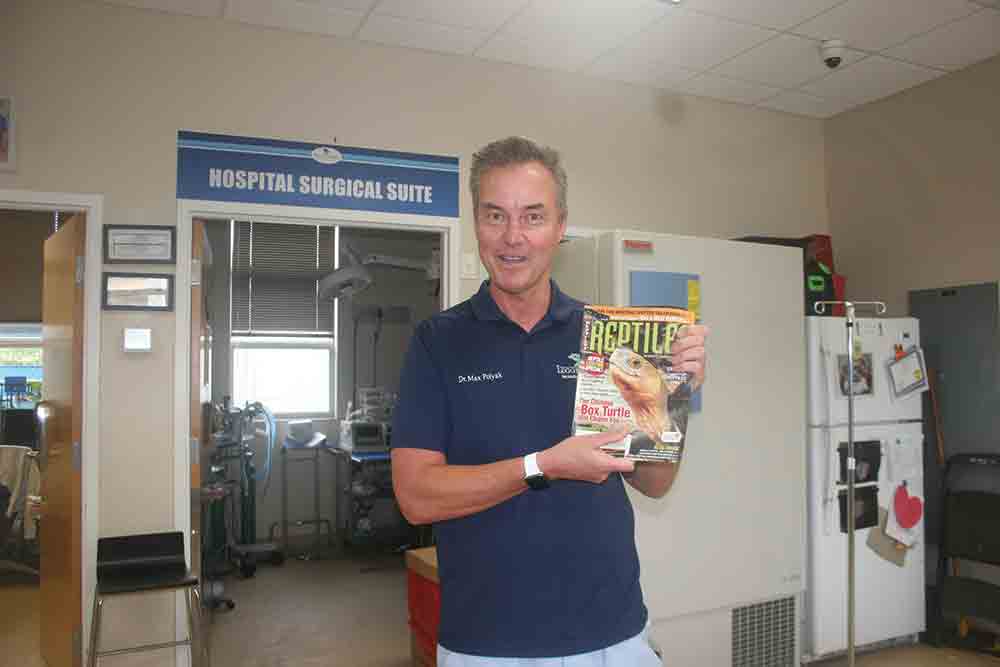
Dr. Max Polyak, LMC’s director of rehabilitation and attending veterinarian, with some excellent reading material. Photo by Rebekah Pettit
RP: How has captive care changed for sea turtles over time at LMC?
LMC: LMC’s rehabilitation process follows a “rescue to release” protocol, which means that sea turtle patients are released as soon as they are medically cleared. If a patient is deemed non-releasable, it will be transferred to a different facility. All of the sea turtle patients on campus are actively receiving treatment with the ultimate goal to return each sea turtle back into the ocean as quickly as possible. Medical care has changed to reflect advances in new therapies, many of which were developed at LMC. This includes molecular and precision-based medical techniques.
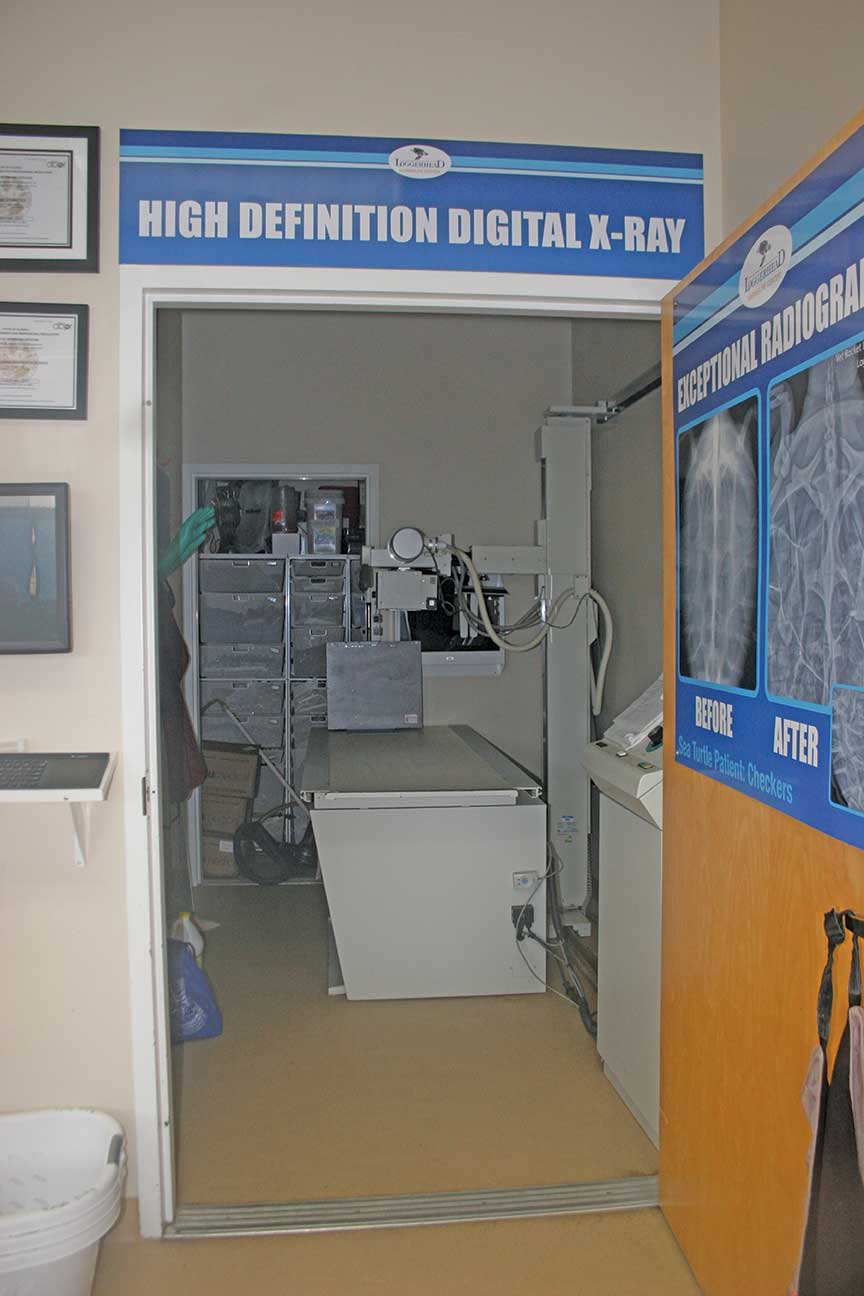
Digital X-ray room. Photo by Rebekah Pettit
RP: Are there quarantine periods/how do you quarantine?
LMC: Our staff will feed in mornings, midday, and evenings or a version of those periods, always out of view of the public so no association between feeding and humans is made. Since all of our patients are returned to the wild once they have been medically cleared, it is important that they have as little imprint as possible from humans. Hospital staff conducts treatments and transports patients from the outdoor to the indoor hospital for our veterinarian to perform diagnostics, treatment, surgery and other procedures. LMC is a fast-based, teaching hospital and is among the busiest and largest sea turtle hospitals in the world. We are also open 24/7 for any emergency.
RP: Do sea turtles eat daily?
LMC: Yes. They are fed between once and several times a day, depending on their medical condition. All feeding occurs before and after guests come to visit our Center so the patients don’t associate people with food.
RP: What are some examples of sea turtle enrichment done here?
LMC: PVC pipe playgrounds. While in their natural environment, sea turtles keep their shell free of algae and barnacles by using sponges, rocks, and so on as rubbing posts. We provide patients with various devices made from PVC piping and hard bristle brushes to encourage this natural behavior.
RP: What is the most important thing about caring for sea turtles in captivity?
LMC: The most important feature of hospitalized care of any wild animal, including sea turtles, is to treat and heal them as effectively as possible so that they have the best chance at success in thriving in the wild. This is one of the missions of the Sea Turtle Hospital at LMC.
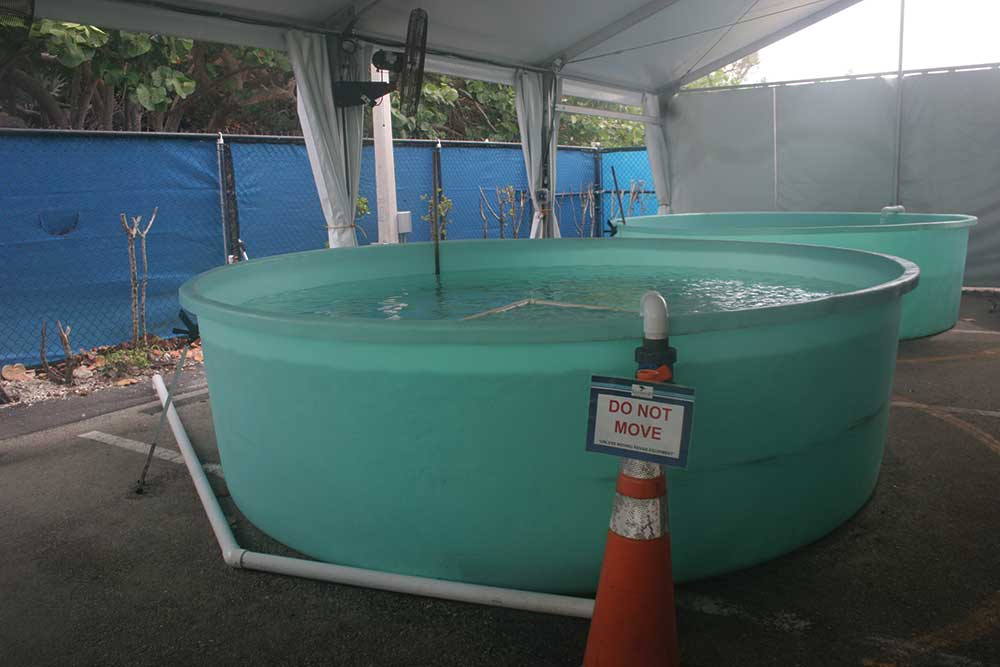
Each sea turtle has its own rehabilitation pool. Photo by Rebekah Pettit
RP: What does record keeping look like at LMC?
LMC: For the hospital, we use a customized digital medical records system much like one would find in a human hospital.
For the research team, we use sub-meter GPS units and good old paper and pencil to document nesting activities. These data are then input into a local database for processing. Eventually, the data are submitted to federal, state, and local authorities.
RP: Are there any new or emerging diseases in sea turtles, like those seen in tortoises?
LMC: Yes, there are always diseases that are newly identified or that have changed in biological behavior, so we are constantly aware of the presence of emerging pathogens that may cause disease in these and other marine animal species. Emerging pathogens and disease detection and surveillance are a major aspect of what we do at LMC.
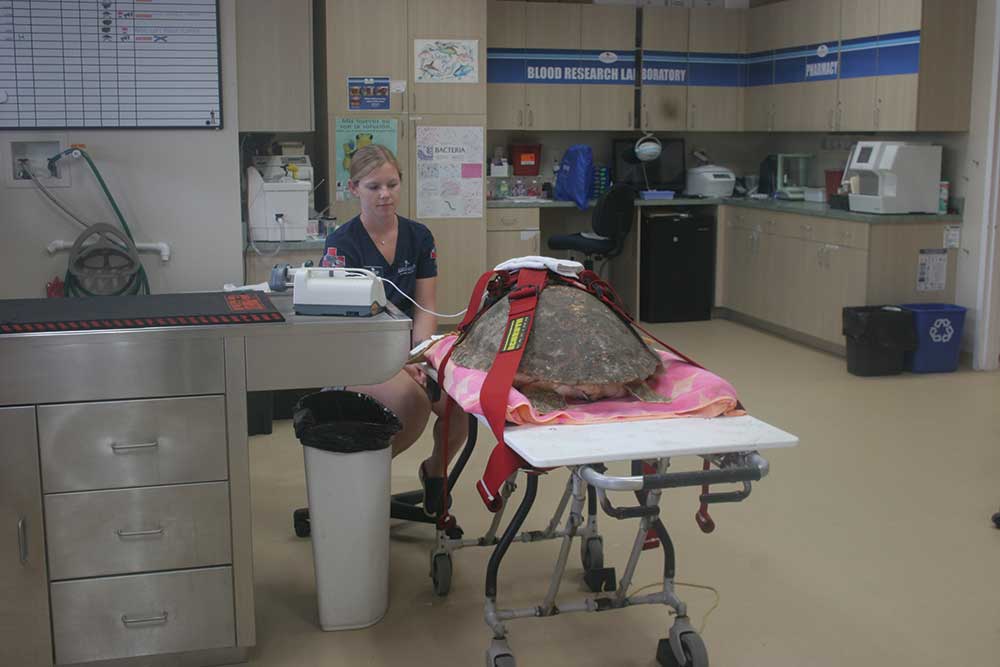
The sea turtle are secured to ensure no mishaps occur. Photo by Rebekah Pettit
RP: What are the most common illnesses in Sea Turtles? (bacterial, fungal, etc.)
LMC: The most common illnesses found in the Sea Turtle Hospital include buoyancy disorder (inappropriate floating), chronic debilitation (starvation), trauma (boat strikes and fishing gear entanglements) and predation (shark attacks). Nearly every presenting condition will have a pathogenic component.
RP: Are sea turtles social?
LMC: No, sea turtles are very solitary creatures. They rarely interact with one another outside of courtship and mating.
RP: Could you explain sea turtle thermoregulation? How do they maintain their body temperatures in the water? (rehab/research)
LMC: Sea turtles are ectotherms, so they depend on the external environment for temperature regulation. This is a consideration of ours when treating patients as we make considerable effort maintaining our hospital tank temperatures within a narrow range so our patients can heal quickly. The exception to this are leatherbacks, which utilize a modified endothermic strategy.
RP: Are there any captive related issues to keeping these animals? Have you observed shell pyramiding in sea turtles?
LMC: We often consult on cases at facilities around the world where sea turtles are kept in permanent captivity. Nutritionally mediated disease is among the biggest problems associated with this population. This can manifest as shell deformities but rarely pyramiding. Treatment of cases like this is difficult and often unsuccessful.
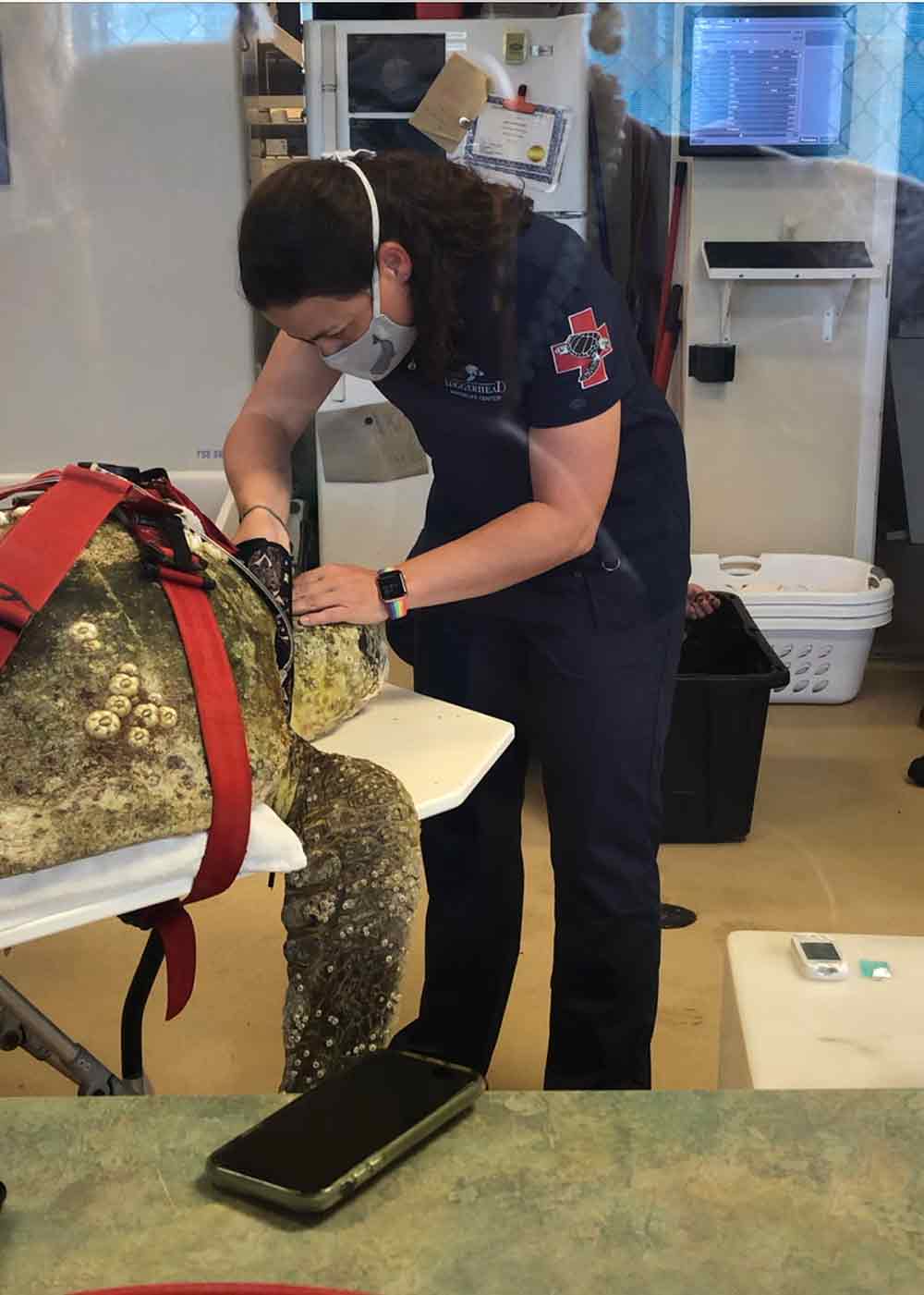
RP: Are surgeries challenging on these reptiles? Anesthesia, etc. Do you have a specialized reptile vet or an exotic vet?
LMC: Yes. All the drugs that we use are human medications, so we must use our experience and training to modify their use in these species. Surgery can be very challenging since the anatomical limitations of access to various organ systems require a great deal of surgical creativity. Sea turtles can shunt their blood, which adds complications to the anesthetic event. All surgeries have been performed by leading experts within Hospital. We have in-house, specialized veterinarians, Dr. Max Polyak (Director of Rehabilitation and Attending Veterinarian) and Dr. Charlie Manire (Chief of Rehabilitation). Dr. Charlie is celebrated for helping write the Sea Turtle Health & Rehabilitation, which is the first-ever comprehensive book on sea turtle health, medicine, and surgery.
RP: What is the most common object found in turtle stomachs (not food). LMC: Foreign objects are typically not found in our patients’ gastrointestinal tracts, but when they are, they are comprised of everything from hard plastics to Styrofoam to balloons. In contrast, 100 percent of post hatchlings (~less than 1 year old) that we have admitted to the hospital at LMC have ingested some form of microplastics.
RP: When is euthanasia considered? Is it common? Are there legal challenges to this?
LMC: Euthanasia is only considered by our veterinarian if medical intervention would have little chance at success at relieving suffering or saving the patient. Fortunately, this is not common at LMC. We’re happy to report that we have a 90 percent success rate in rehabilitating and releasing our patients. Also, there are no legal challenges to this as euthanasia is a permitted activity under state and federal law when practiced by a licensed veterinarian.
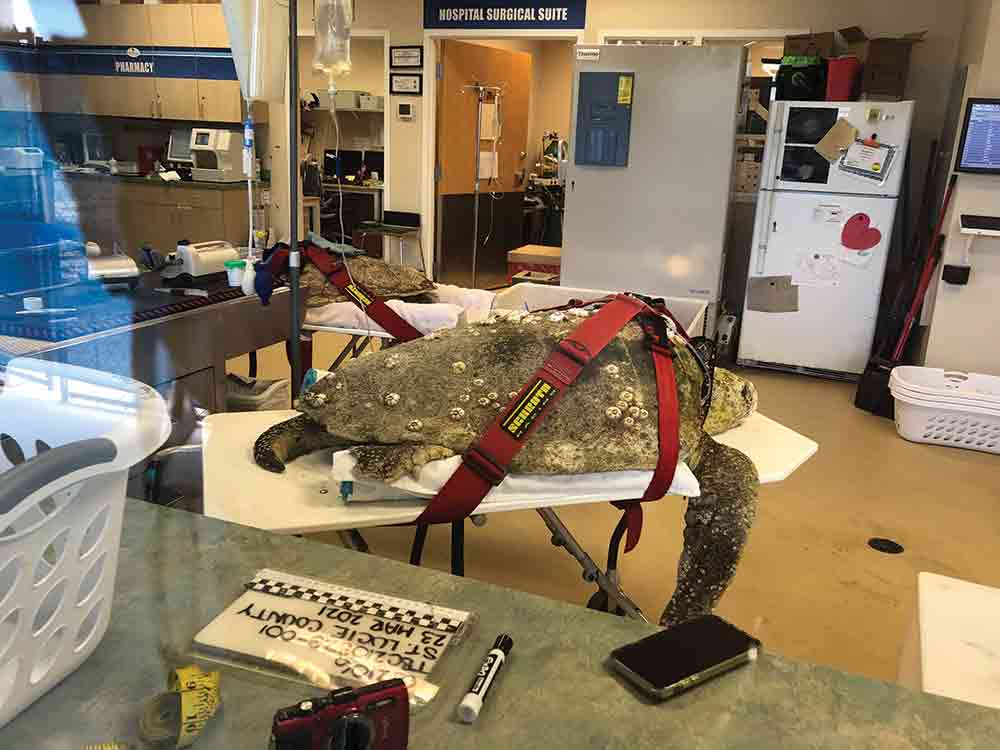
Some of the common illnesses that sea turtles get include buoyancy disorder starvation, and trauma from boat strikes and fishing gear entanglements. Photo by Rebekah Pettit
Conservation
RP: Are there ambassador animals at LMC? (Sea turtles that can never be released)
LMC: No, if a sea turtle cannot be released it is transported to another facility or is humanely euthanized by the Attending Veterinairan in consultation with Florida Fish and Wildlife Conservation Commission.
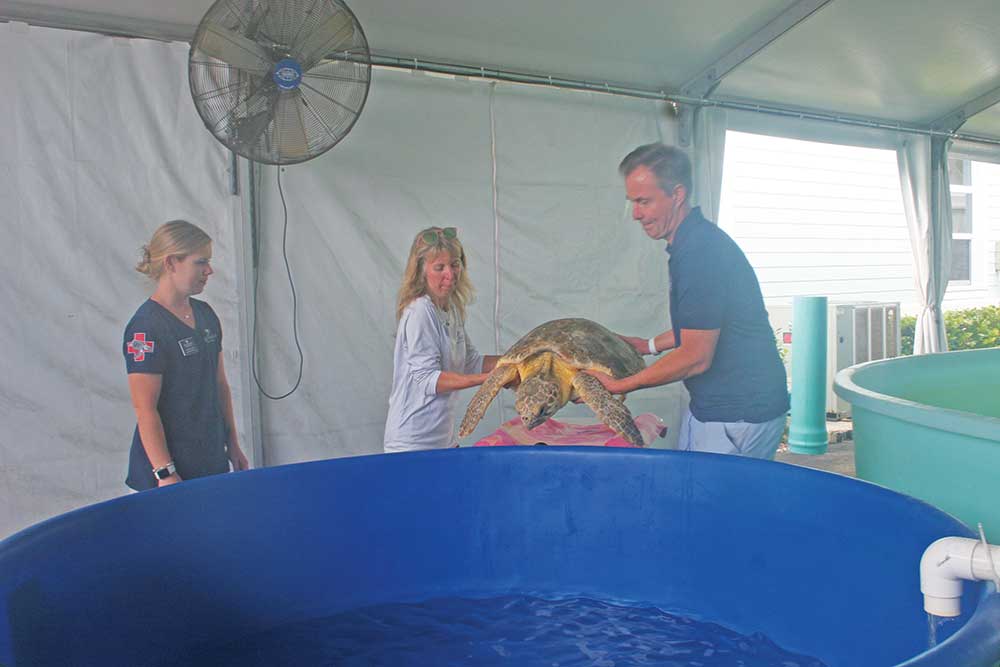
It takes two people to place a sea turtle in the hospital tank. Photo by Rebekah Pettit
RP: Are all sea turtles endangered? Are there any status changes on these species (endangered species act was created in the 70s – how was life different for sea turtles before they were on the endangered species list?
LMC: Worldwide, six of the seven sea turtle species are classified as threatened or endangered due to human actions and lifestyles. There are status changes thanks to the ESA. However, this varies by sea turtle classification. For instance, nest counts over the last 25 years on Florida beaches show that green sea turtle nesting has increased exponentially. Whereas loggerheads have not shown any definitive recovery in numbers.
Before the ESA, life was different for sea turtles in that there was a greater chance of poaching, harvesting, illegal trade, bycatch through gill nets, etc. without major repercussions. Also, a lack of local ordinances, such as turning off artificial lights caused a lot of hatchlings to become disoriented.
RP: What are the federal protections for sea turtles? Does this apply outside the USA?
LMC: We have the Endangered Species Act, which is the primary law for protecting imperiled species in the United States. Yes, this applies outside of the USA. Since its inception, the act has stated that all species in danger of extinction be listed, regardless of their country of origin.
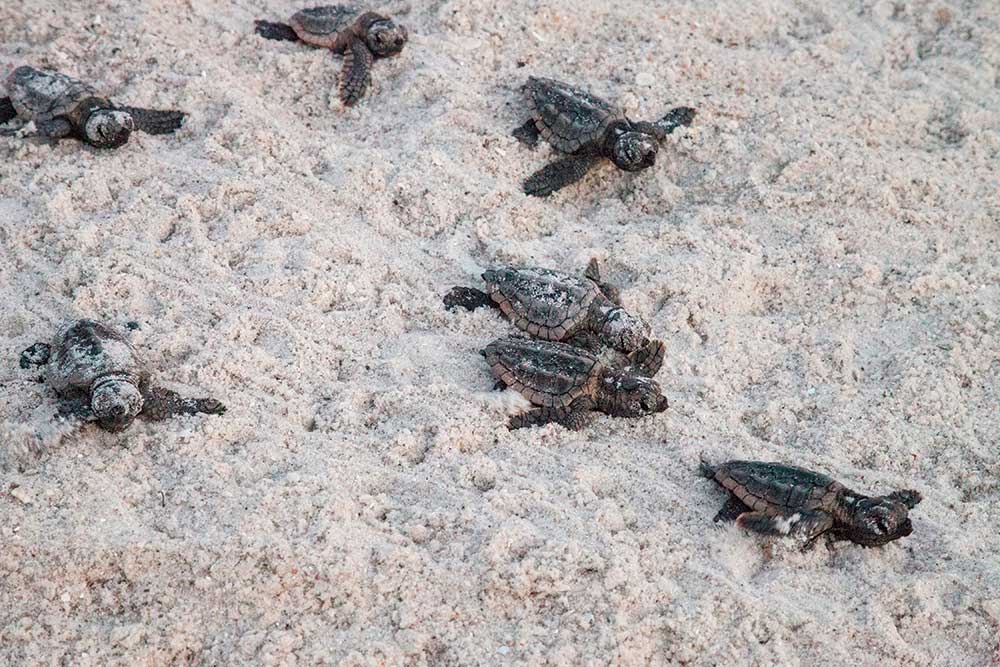
100 percent of hatchlings treated at the marine life center have ingested some form of micro plastics. Photo by Sunflower momma/Shutterstock
RP: When transporting sea turtles across state lines, are there legal challenges?
LMC: All transport of sea turtles, or any part of them (blood, feces, etc.) requires permitting by state and federal authorities.
RP: Why aren’t hatchlings released into an estuary where they can safely grow? Are hatchlings marked?
LMC: Their instinctual destination is to be in ocean waters. Sea turtle hatchlings head for the Sargasso Sea when they hatch, and many species spend the beginning of their lives in the shelter of the sargassum. With over a million hatchlings produced on just our 9.5 mile stretch of beach, marking hatchlings is not a realistic undertaking. We let hatchlings naturally emerge from their nests at night and make their way to the ocean without intervention.
RP: Why aren’t clutches collected and artificially incubated?
LMC: FWC regulates the protection and conservation of sea turtle nesting in Florida and therefore restricts what activities can and cannot take place. Therefore, unless there are research projects that require artificial incubation, this practice is not permitted for Florida beaches. In Florida, we don’t have extensive poaching issues so letting nests incubate in situ is the best management practice. For certain beaches, like the ones that LMC monitors, we could not realistically move and artificially incubate 10,000 nests/year. Instead, we focus on monitoring our local nesting population to identify trends as well as document and address the anthropogenic impacts (e.g., artificial lighting, coastal development/armoring, etc.) on sea turtle nesting.
RP: How long are clutches incubated for?
LMC: Leatherbacks incubate for 60 days on average, while loggerheads and greens incubate for ~50 days on average. However, incubation period is temperature dependent, and as it gets warmer, incubation period declines.
RP: Is academic research common with your sea turtles? Examples?
LMC: Yes, we have academic research manuscripts being published on a regular basis. A good chunk of our publications are funded in part by a grant awarded from the Sea Turtle Grants Program.
RP: What is the most memorable rescue?
LMC: There are far too many to list. What’s most special are the releases – it’s the culmination of tons of hard work from everyone involved to release these noble and ancient creatures back home to the wild. It never gets old!
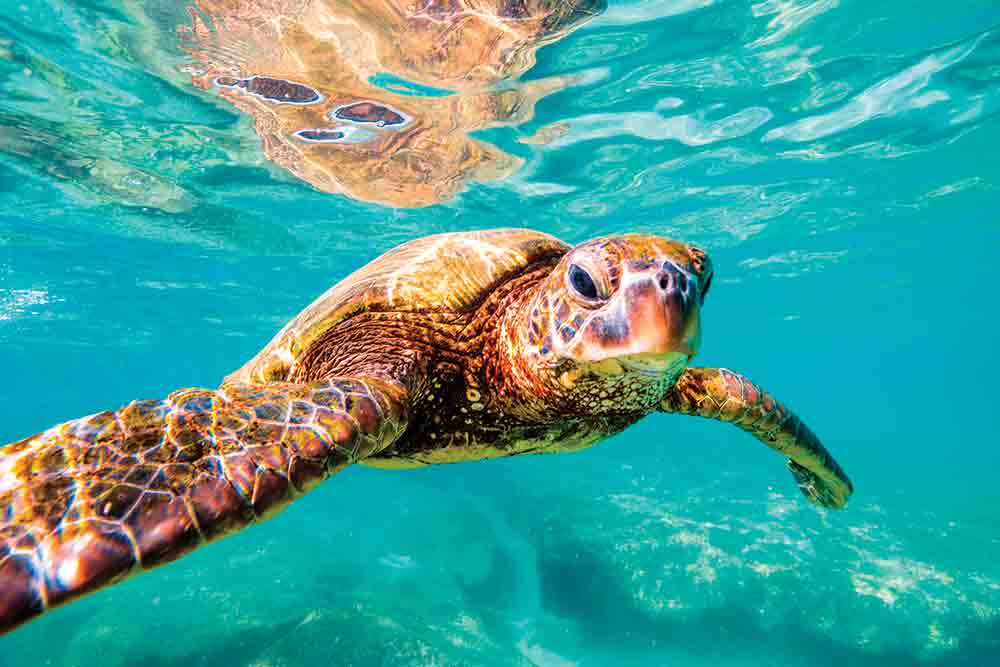
Worldwide, six of the seven sea turtle species are classified as threatened or endangered due to human actions. Photo by Shane Myers Photography/Shutterstock
RP: What are some mysteries that still surround sea turtles?
LMC: Lots! To name a few….we don’t know how to age sea turtles. We don’t know why they choose to nest where they do (both along the coast as well as along the beach width). We don’t know where hatchlings go when they leave the beaches and how they navigate back to their natal regions to nest once they are reproductively active. We don’t know the ratio of males to females in the population and if that ratio is changing as a result of global warming. We don’t know a lot about their basic health, including things like blood types and how their immune systems work.
RP: If someone sees a hurt sea turtle, what should they do?
LMC: If you ever happen to encounter an injured or stranded sea turtle, please call Florida Fish and Wildlife Conservation Commission (FWC) immediately at 1-888-404-FWCC (3922) or you may dial *FWC or #FWC on your mobile phone.
RP: How can we best support LMC?
LMC: There are numerous ways to support LMC. You can sign up for self-guided beach cleanups that are held every Saturday on Juno Beach, volunteering, becoming a blue friends society member or adopting a sea turtle patient, which helps support medicine needs, tank maintenance, food supply, etc. Guests can also support financially through LMC’s annual fund, emergency relief funds from COVID-19, donating to our capital campaign and so much more. Any donation is greatly appreciated as we like to welcome guests free of admission and rely on the support of donors to keep this status.
Final Thoughts
Sea turtles are seen as strong, brave, guardians of the Earth, but their tough shells and patient ways are fragile in the reality of the world. It is possible for sea turtles to make a recovery, which can be seen through the amazing efforts of conservatories like Loggerhead Marinelife Center and the Sea Turtle Rescue Alliance. Even individuals can impact the conservation of sea turtles, and the smallest choices can benefit them like recycling, donating, and supporting conservatories. Sea turtle conservation is a leading effort in herpetology, and I am grateful we live in a time that is progressing with hopes to preserve ALL turtles. They say “it takes a village,” and it is one on the back of a turtle. Sea turtles are charming creatures that are important to the planet and humanity. They have existed for so long as beautiful, diverse, one-of-a-kind reptiles, and extinction would be a disastrous loss.


